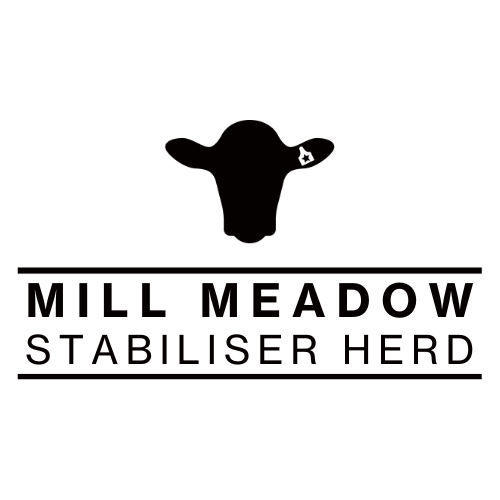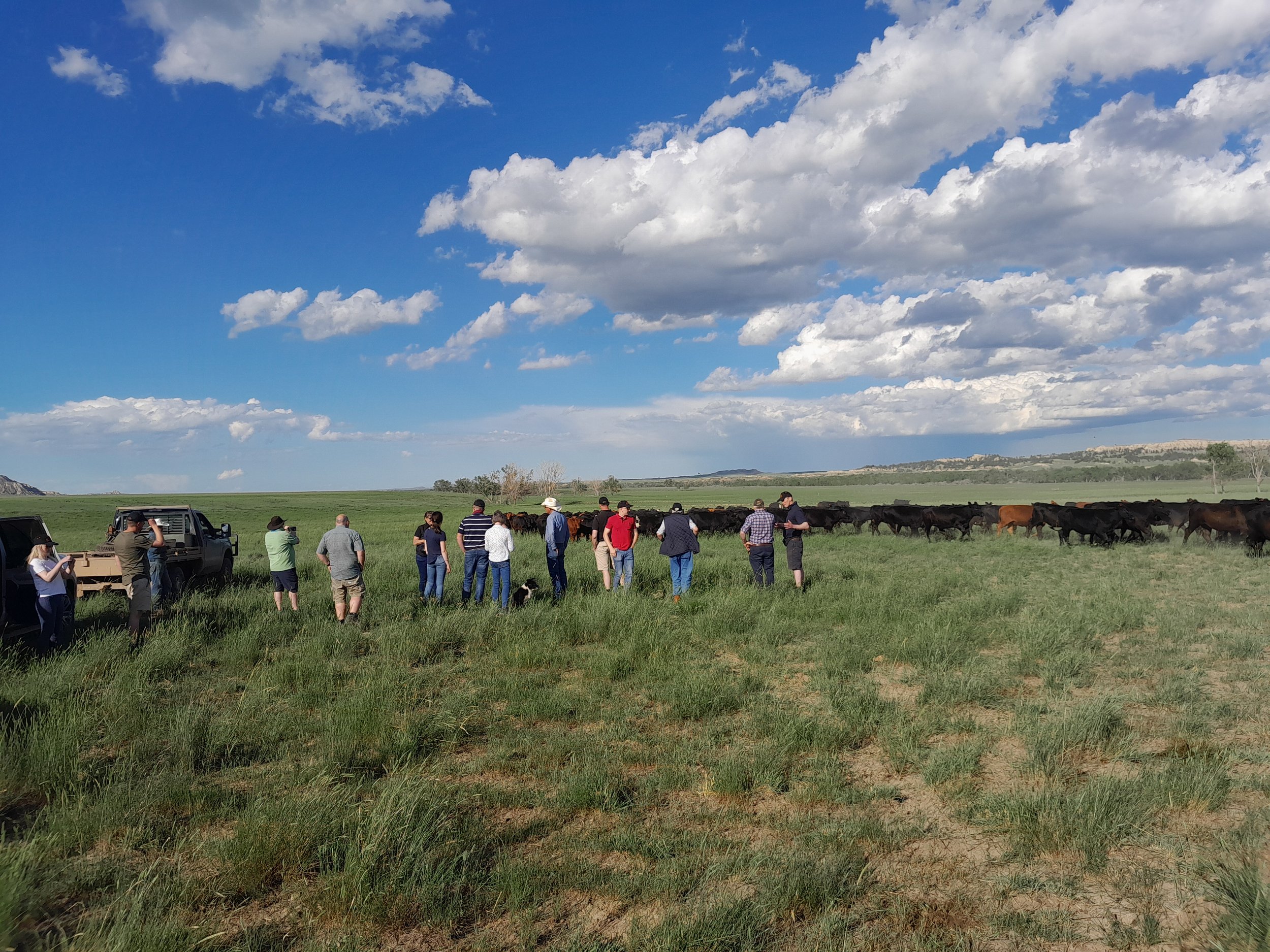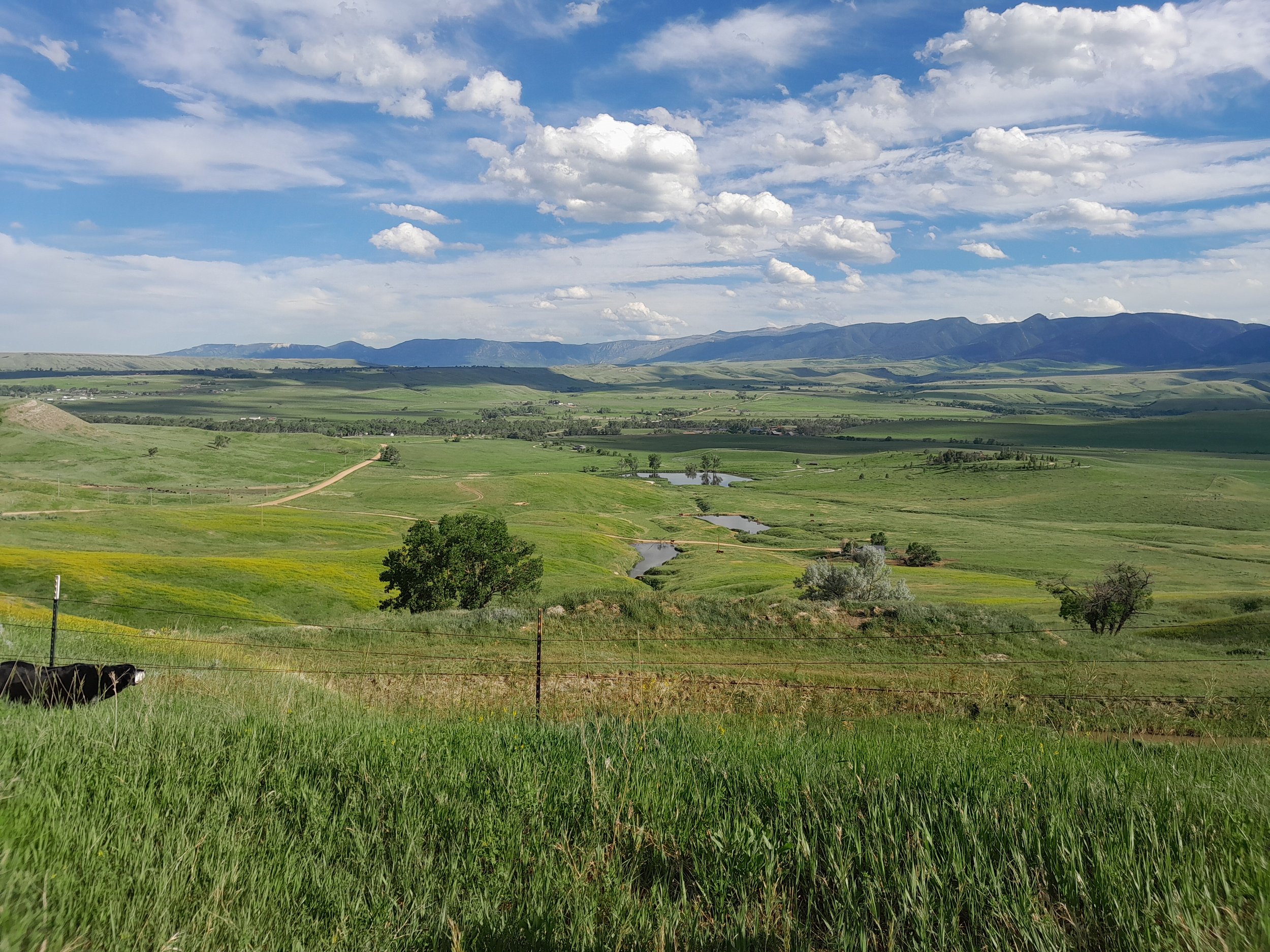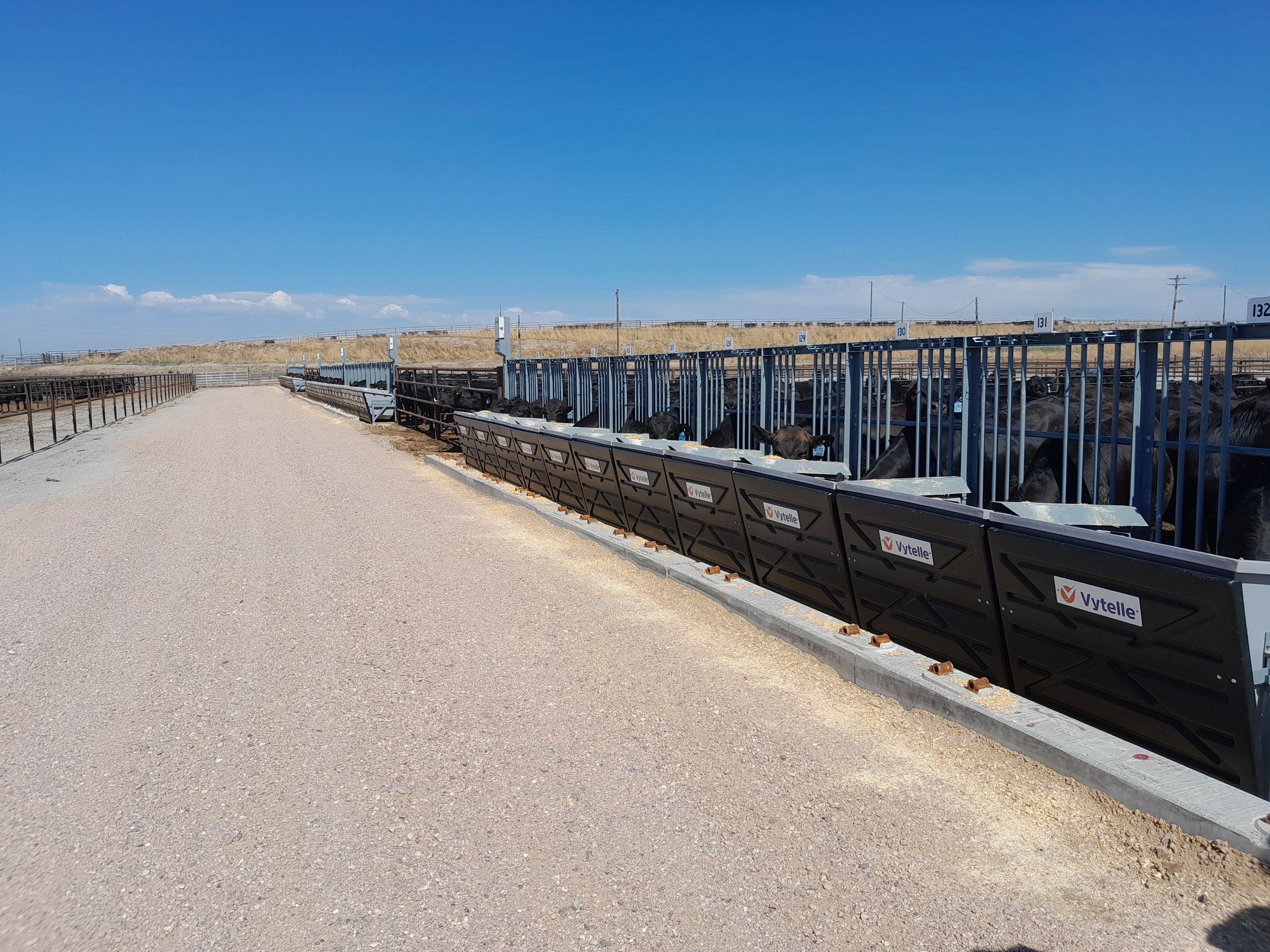Stabiliser Cattle Company 2024 USA Tour
The Stabiliser Cattle Company took a group of 20 farmers to the USA for a week, from the 8th to the 16th of June 2024. I was able to go on this trip to see the Stabilizer breed in the USA. It was inspiring and insightful.
We landed in Denver, Colorado, and travelled North to spend our first night in Cheyenne, Wyoming. The morning brought the longest drive of the trip, in a convoy of four wheel drives we sped through Wyoming and South Dakota eventually arriving at the Alkali Ranch, home of the Grubl family. On the way we drove through the gold rush town, synonymous with the Wild West, of Deadwood, South Dakota.
Alkali Ranch, Sturgis, South Dakota
There were three generations of Grubls at work on the day that we visited, it was great to see the children playing on the backs of the ranch horses. The Grubls are co-operators in the Leachman Stabilizer breeding program. Co-operators have a similar role to multipliers in the UK. This was by no means the hardest land we saw on our trip, but it was surprising to see how sparse and hard the landscape is in comparison to our grazing in Norfolk. The cattle need to be tough and able to make the most of the forage. It was fantastic to see the cattle brought off the range and into the corral with horses, this was true cowboy style as we might imagine from watching the movies. As a multiplier breeder in the UK I was able to quite easily relate to the protocols described for recording cattle, and the cattle handling system was really interesting, it featured a bud box and was made on the ranch.
Cattle at the Alkali Ranch.
Rieger Ranch, Plevna, Montana
Our next day, after a night in Sturgis, South Dakota, saw us drive into Montana to visit the Rieger Ranch. The Riegers are also co-operators, we saw a bull called Leachman Lazarus out with a bunch of heifers, he was the bull that was lot 1 in the Leachman Spring sale. We also saw Leachman Just Right he has offspring in the UK, I expect we might see some of their ancestors filter through to some of our Mill Meadow breeding. The midges were biting at this stop. The annual rainfall at the Rieger ranch is 12 inches and most of that falls in the spring, it looked green but apparently that changes. During the winter it can get very cold, these cattle are handling conditions which are much tougher than they might experience in the UK.
Cattle on the Rieger Ranch.
Both the first two ranches, the Grubl and Rieger ranches, produce cattle which will feature in the UK Stabiliser breeding program. It was fantastic to see familiar looking cattle in a different environment. Black cattle dominated, there were a few red animals but the Certified Angus Beef program has a big influence on marketing in the USA, black cattle hold a premium price. Both co-operators talked about the importance of not pushing breeding heifers and bulls too hard, they need to grow at a steady pace so that they are resilient in later life.
Glenn Gay’s Ranch, Broadus, Montana
The next stop, after lunch in Miles City, was Glenn Gay’s Ranch. Glenn was a commercial producer with 900 cows, his ranch covered 85,000 acres, some of that was privately owned and some of that was government owned, Glenn explained that although that sounds alot of land, a considerable amount was too marginal to be ranched. Black bears, Mountain Lions and Coyote were some of the wildlife that also called the ranch home. Glenn’s grandfather settled there in 1895, and strangely there was a connection to Norfolk, as Glenn’s father had been stationed at the World War Two airfield at Deopham Green, Wyondham, Norfolk. It was not many years ago that Glenn made a trip to visit Norfolk to see where his father had been stationed. Glenn grew 1,500 acres of hay which was irrigated using water out of the Powder River. The ranch had 62 Stabilizer stock bulls. A plane was used twice per week to check cattle and the water supply. Our bed and steak dinner was in Miles City, breakfast was in McDonalds!
Glenn Gay (with the hat) showing the group his heifers.
Origen Bull Stud, Huntley, Montana
The Origen bull stud is owned by a group of twelve bull breeders, it provides a service to breeders who wish to market bull semen themselves. The stud at the time of visiting had 87 bulls on site, it could hold 220, they were mainly Angus, but we also saw some Herefords and Wagyu. It was interesting to understand the health protocols employed on site and the much greater scrutiny that would be needed if this facility was to want to export into Europe.
Little Bighorn Battlefield, Crow Agency, Montana
Our next stop was the Little Bighorn Battlefield, it is the site of Custer’s last stand in 1876, it was poignant and a good place to understand some of the history that had created the place that we were visiting. 260 soldiers met their death on the top of a hill whilst facing several thousand Lakota and Cheyenne warriors, this was part of an ultimately successful campaign which ended the nomadic Indian way of life.
Beckon Red Angus, Sheridan, Wyoming
In the afternoon we left Montana and headed back to Wyoming and Beckton Red Angus, near Sheridan. Beckton are the founding herd of the Red Angus breed, the circa 55,000 acre ranch was stunningly beautiful, pictures do not do any of the scenery much justice. The 1,100 cows with calves were very impressive, and it was great to see their sale barn where every year they sell their bull crop to ranches across the USA. The ranch house was one of the oldest buildings in the locality, it was built in 1899.
The ranch at Beckton Red Angus, lower lying land surrounded by higher ground. The photo does'n’t do the scenery justice.
Our steak dinner and bed was in Buffalo, Wyoming.
LU Ranch, Worland, Wyoming
The following day we went to the LU Ranch, Wyoming, they are a commercial operation. This was different country, it felt tougher than anything we had seen to date. On their ranch they had an oil field with what must have had several hundred nodding donkeys in operation. The stocking rate was 100 acres per cow, the ranch is 150,000 acres, and holds 1,450 cows. The land ranges from 5,000 ft to 9,000 ft above sea level, they can get between 6 and 12 inches of rain per year. Accessing water is a challenge. They calve from March to April, wean at the end of August and send their calf crop to Lincoln County feed yard. All the replacement heifers are artificially inseminated. Bulls have to be able to walk very well, the bull to cow ratio is low, they are expected to serve 20 cows. Because these bulls are working at altitude they are PAP tested, their pulmonary artery pressure (PAP) is measured, this is a heritable trait and it makes them more suitable for living at altitude. During the winter the main herd live off the range, the 1st calved heifers and breeding bulls receive alfala hay. The ranch grows and consumes 500 tonnes of hay per year. We saw the farmer of the ranch who was cultivating land under a pivot for hay. At this point we learnt some of the history of the ranch, we visited one of the original homesteads and learnt about water rights, and the wars between sheep farmers and cowboys. This was once the home of a Scottish sheep farmer. The history of the ranch also has some crossover with the TV series 1923, a spin off of the Yellowstone TV series.
One of the buildings, albeit with a plastic roof, which formed part of the original homestead at the LU ranch. What looked like the remnants of a garden was growing around the porch.
After lunch in Thermopolis, we headed to Casper, Wyoming for a stop at Lou Taubert’s Ranch Outfitters, a great place to get your Western attire, and also an opportunity to meet and hear from Jim Leachman. Our next stop that evening was the College National Rodeo Finals. It was a phenomenal display of skill on horseback, and great to experience a part of Western culture.
Sawyer Orr’s Summer Place, Wyoming
Having spent the night in Douglas, Wyoming we headed of to see Sawyer Orr’s summer place. This ranch was a bit easier to relate to what we do at home, he had a similar number of cows and the country was not so extreme. The scenery was, once again, stunningly beautiful and the cattle were brought down through the trees to see us by cowboys on horses. Sawyer’s story was familiar, he was profiting from the fertility and feed efficiency of the Stabilizer cow, he had understood the ethos behind the Stabilizer and thought that it fitted with what he wanted to achieve. Sawyer runs a commercial cow calf operation. He was achieving great success with artificial insemination. The cattle are on 10 acres per cow calf pair, they go onto corn stalks and alfalfa bales when there is too much snow at his summer place. He fence line weans in September and calves back at his ranch.
Cattle at Sawyer Orr’s summer place.
We were treated to some wonderful food at the end of the tour, Sawyer and his family with Aaron Rasmussen from Leachman Cattle had cooked steak on a outdoor grill which was next to a lake where Sawyer had built a cabin.
Leachman Wyoming Ranch, Meriden, Wyoming
In the afternoon we went to the Leachman ranch in Wyoming, here we saw some of the cows who will be embryo donors for embryos heading to the UK, it was really interesting to see the set up and understand how this part of the business works.
We finished the day with a great meal at Sandfords Pub and Grub in Cheyenne, i had a burger with peanut butter on it, it was great! After that we headed to Fort Collins to find another Days Inn to stay in.
Colorado State University, Fort Collins, Colorado
Unusually, our first event on the next day required only fifteen minutes of travel time, we went to Colorado State University, in Fort Collins. We heard from two speakers, both really interesting, and both part of the AgNext group, one talk on animal welfare and the other on beef sustainability. Breeding has a really important part to play in beef sustainability. We also had a tour of the facilities at Colorado State University, they have a whole meat processing facility within their university building, it was a phenomenal facility, which was run by students. We saw the handling facility that was designed by Temple Grandin.
Fiver Rivers Cattle Feeding, Kersey, Colorado
Our next stop was Five Rivers Cattle Feeding, Kuner feedlot in Colorado. The size was phenomenal, the company is the largest cattle feeder in the world. It’s not something that I would ever expect to translate to the UK, but a real education to see. Kuner feedlot can hold 100,000 head of cattle. Each animal has 160 square ft per head and stays on the yard for up to 180 days, there is 52 miles of trough space with five feed trucks serving that. The biggest part of the animals diet was steamed flaked corn, which i think is basically Corn Flakes, it certainly looked like it.
Kuner feedlot with the feed mill in the background.
Leachman Bull Barn, Fort Collins, Colorado
The final part of the day took us to the Leachman Cattle Company bull barn, here we saw the really elite bulls, and the barn where the bull sale is held. Lee Leachman talked us through the story of the business, and how the new association with the URUS group works. There was some great discussion about how the breeding indexes work and how what is happening in the USA might relate to what we as cattle breeders are doing in the UK. We again were the recipients of some great hospitality, which of course involved steak on the grill, it was great to meet all of the team behind the business and understand what their roles involved.
We headed back for another great evening in Fort Collins.
Diamond Feeders, Greeley, Colorado
Our final day saw us visit Diamond Feeders, they have a longstanding relationship with Leachman Cattle. On this feedlot we saw a lot of Stabilizer x dairy animals, these crosses are gaining a lot of traction in the USA, there are different Stabiliser lines for Holstein, Holstein cross Jersey, and Jersey cows. There is some serious feed efficiency work happening at this site with a new investment which involves the installation of a lot of feed bunks which are measuring feed intake, this data is being used in combination with genomic analysis to select feed efficient bulls.
A small selection of feed bins measuring the feed intake of Stabiliser cross dairy fattening cattle.
That visit concluded our cattle tour, we burnt an hour in Scheels on the way to Denver airport and flew back to Heathrow.
What are my conclusions? I was really impressed, i loved the outdoor lifestyle with so much space and the spirit and energy that is generated from that. I really enjoyed seeing the ranchers, the rodeo and learning from Colorado State University. The feedlot is interesting. I think beef from the ranches that we saw would be acceptable to the UK consumer, however the feedlot maybe not so much; is that a rational view or is it aversion to the scale? Whatever side of the argument we fall down on, it is very evident that there is a lot to learn from this phenomenal beef producing region. As a Stabiliser multiplier breeder in the UK we benefit from this effort in understanding traits such as feed efficiency and fertility, which in the end translates to the bottom line and benefits our cows as well, a factor that we cannot ignore. But we need to be working in partnership with our friends in the US and taking some of the initiative ourselves to make sure that we optimise our breeding for our circumstances, for us our system is a bit more about grass.
One common thing that we can all agree on and celebrate -harking back to our meal at Sawyer Orr’s- is that the process of cooking, serving and sitting in the sun with some salad, and a beer out of the cooler and nice marbled flame grilled steak, that is universally a great pleasure. Something that we all strive for.
Steak at Sawyer Orr’s. Photo credit: Gareth Scott









